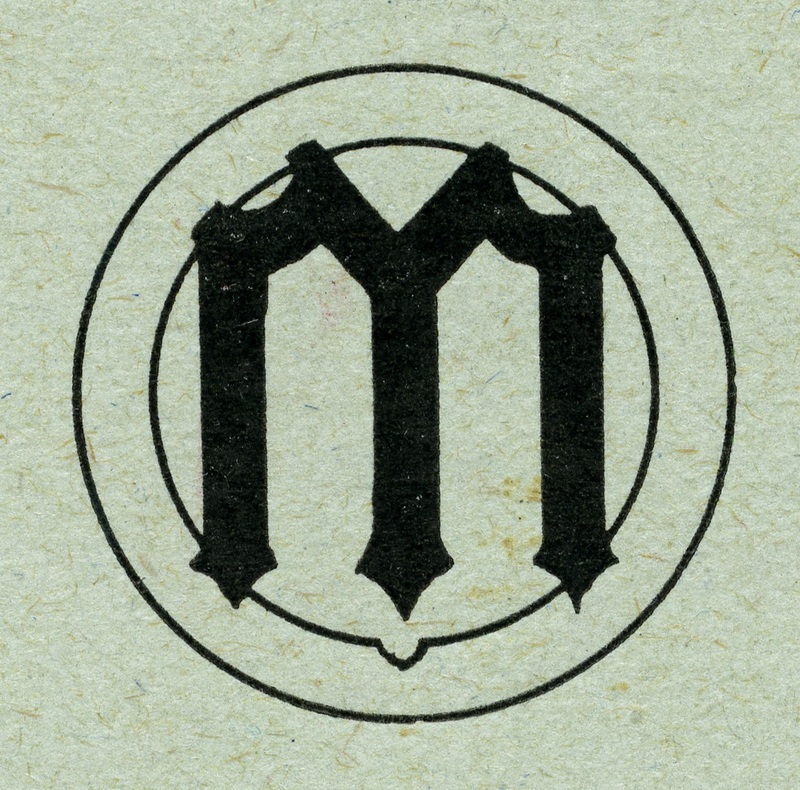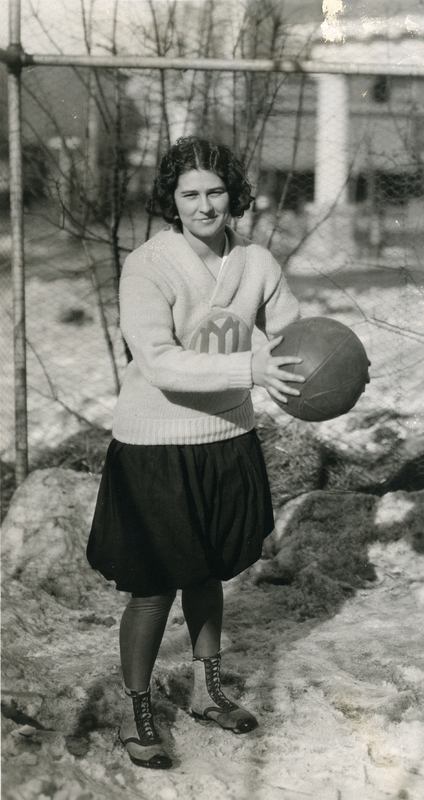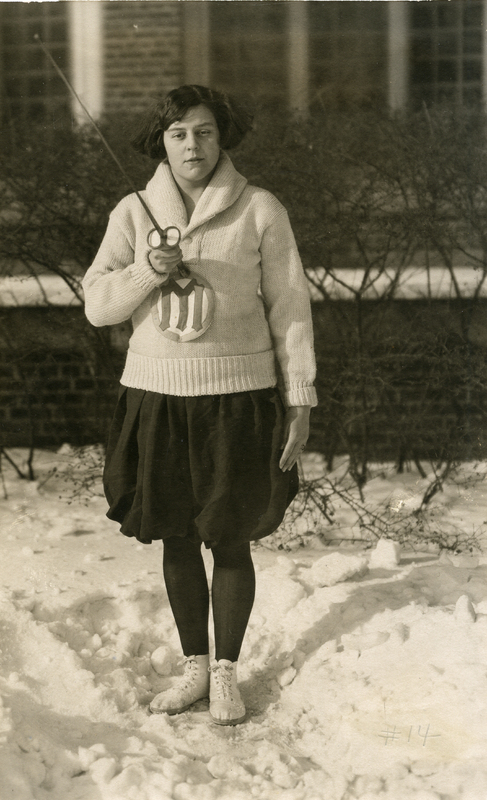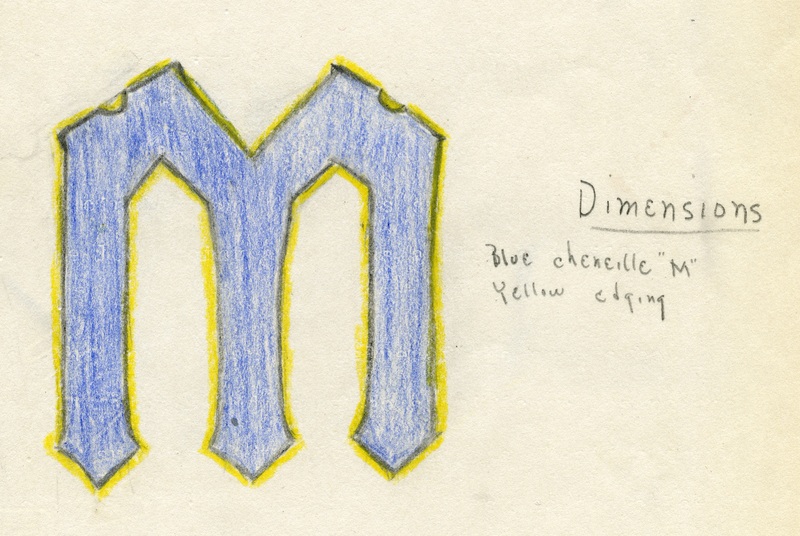Rise and Fall of the Woman's 'M'
The Women’s Athletic Association (WAA), founded in 1905, identified awards and recognition for female athletes as an early priority for the organization. Silver pins were handed out to members of the organization in its first year.[1] By 1914, the WAA desired the same recognition for women athletes as the University provided for men, and set in motion an attempt to acquire the varsity ‘M’ award. The ‘M’ award, however, was a “privilege,” and as a result the WAA was obligated to appeal the University Athletic Association for permission to distribute the award.[2] When the news of this request became public, opposition swiftly arose on campus. Almost a dozen articles appeared in The Michigan Daily in the week prior to the Board’s decision. Opinion was not in the WAA’s favor. “[The women] want the ‘M,’ but they have no intercollegiate competition and no athletic prowess,” wrote one author. “Why not give them a ring, a sweater, or an arm-band, but not the Michigan ‘M,’ or any type of ‘M’.”[3] The Board of the University Athletic Association agreed with these sentiments, and denied the WAA members permission to wear an ‘M’ in “any form.”[4]
Following the ruling, the WAA experimented with other various athletic awards in place of the iconic ‘M.’ Blue silk ribbons with gold print were awarded to female athletes after 1914, with pins awarded for seniority.[5] In that year the WAA also formalized their awards system, called the Honor Point System. The Honor Point System would remain the architecture for women’s athletic awards for almost 30 years. By accomplishing athletic achievements, such as competing in interclass sports—the highest level of competition at the time—or by winning a tournament, an athlete would acquire “honor points.” When a certain number of points had been earned, that athlete would receive an award.
In 1917, the WAA, perhaps ignoring the ruling from a few years prior, created a new emblem for their organization and awards, and it was an ‘M.’ The WAA’s ‘M’ was quite distinct from the varsity letter—perhaps to avoid controversy. It was thin and blue, and circled with a yellow band. Despite the differences in style, the function of the WAA ‘M’ was identical to that of the men’s ‘M’—it was the highest athletic award a U-M athlete could achieve. Analogous to the men’s varsity jacket, the WAA also awarded sweaters “[that were] to be white, with roll collar, and with a blue M on a yellow background.”[6]
The WAA was aware of men’s skepticism regarding the athletic skill and competitiveness of women’s athletics. Accordingly, the ‘M’ sweater wasn’t attainable for those with “no athletic prowess.” In order to acquire the necessary 1000 honor points, a letter-woman would have to be highly skilled in multiple sports. She was required to play a team sport every season (basketball, field hockey, and baseball), while also being successful in individual sports (tennis, fencing, or track), and she would have to remain one of the best women athletes throughout her years on campus. This challenge ensured that only a few remarkable athletes earned the sweater award; from 1924-1926, only thirty-two women acquired the ‘M’ sweater.[7]
The Honor System and the WAA ‘M’ award continued until the mid-1920s, until ideas about the purpose of the WAA began to diverge. To some student members of the organization, the success of the WAA in constructing a competitive athletic structure for women seemed to signal the beginning of an intercollegiate athletic organization. Some even suggested that women attain varsity status. However, not all shared that vision for the future of the WAA, and some were alarmed by this emphasis on competition. Not only were the strains of competition viewed as destructive to the female body, but also to the organization. “Intercollegiate athletics contests are bound to benefit the few,” board member and student manager of the riding club Marie Hartwig publicly stated in 1927. “[A]ll women must be given opportunity for athletic contests.”[8] Rather than focus the organization's resources on varsity athletics, which only a few women would benefit from, this faction of the WAA wanted to include as many women as possible—“Athletics for All” became their slogan.[9] The women in charge of the WAA during the mid and late 1920s supported “Athletics for All,” and the momentum for women’s varsity status eventually subsided.
The philosophy favoring participation over competition gained favor throughout the late 1920s and early 1930s, which shaped not only the structure of the WAA, but the ‘M’ award as well. In 1929, the WAA began lowering requirements in the Honor Point System, in order to encourage participation. The necessary points for the ‘M’ sweater were reduced, but the question was also raised “if [it should be] awarded at all.”[10] However, the award survived and evolved throughout these structural and programmatic changes. In 1929, navy blue woolen jackets came to replace the white sweaters.[11] The ‘M’ award was updated in 1935, this time without the yellow circle.
Despite the adjustments to the ‘M’ award, the WAA continued to move closer to eliminating awards from their organization altogether, while also diminishing competition. Many women’s sports throughout the 30s began operating on a club basis, where competition was hardly the focus. With fewer sports emphasizing competition, the idea of distributing athletic awards seemed contrary to the WAA’s purpose. In 1936, the ‘M’ award was eliminated completely, and the women’s athletic award became a blue and yellow scarf, awarded more for participation rather than for skill.[12] Women’s athletic awards disappeared entirely by the 1940s. It would not be until 1975 that women would once again be awarded for their athletic achievements.
[1] “History of the W.A.A.” Women’s Athletic Association 1926-1928, Box 1, Women’s Athletic Association (University of Michigan) records: 1905-1962, University of Michigan Bentley Historical Library, Ann Arbor, MI.
[2] Minutes, 1912/13-1913/14, 20 February, 1914, Box 2, Women’s League records, University of Michigan Bentley Historical Library, Ann Arbor, MI.
[3] Y.F. Jabin Hsu, “The ‘M’,” The Michigan Daily, February 22, 1914
[4] The Michigan Daily, “Board Refuses Request from Women for ‘M’,” February 26, 1914.
[5] Minutes, 1912/1913-1913/1914, Box 2, Women’s League (University of Michigan) records, University of Michigan Bentley Historical Library, Ann Arbor, MI.
[6] Women’s Athletic Association 1926-1928, Box 1, Women’s Athletic Association (University of Michigan) records: 1905-1962, University of Michigan Bentley Historical Library, Ann Arbor, MI.
[7] Ibid.
[8] “W.A.A. Head Says Michigan Is Not Ready For Women’s Intercollegiate Athletics,” November 1927, Scrapbook, Box 6, Women’s Athletic Association (University of Michigan) records: 1905-1962, University of Michigan Bentley Historical Library, Ann Arbor, MI.
[9] Ibid.
[10] Women’s Athletic Association 1928-1929, Box 1, Women’s Athletic Association (University of Michigan) records: 1905-1962, University of Michigan Bentley Historical Library, Ann Arbor, MI.
[11] Ibid.
[12] Women’s Athletic Association 1935-1937, Box 2, Women’s Athletic Association (University of Michigan) records: 1905-1962, University of Michigan Bentley Historical Library, Ann Arbor, MI.





